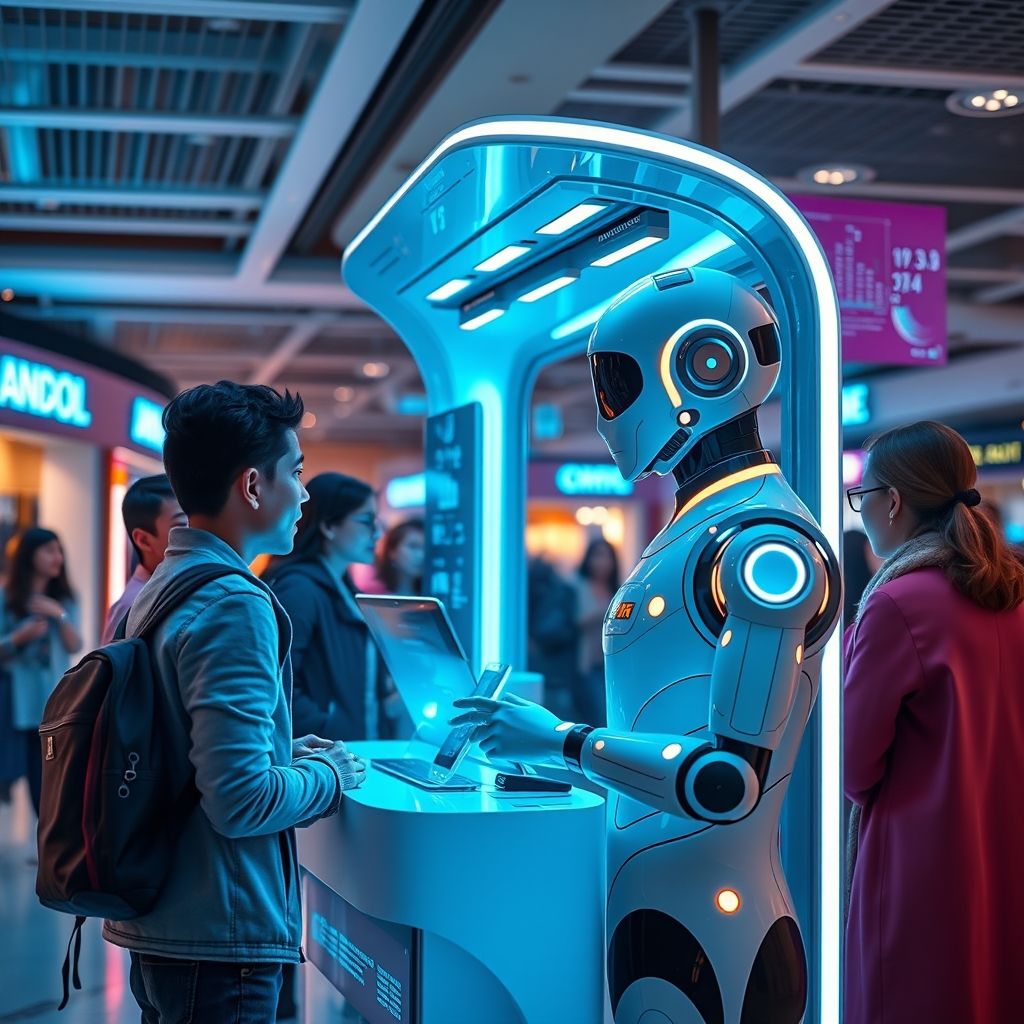Introduction: The Quiet Revolution Happening in Your Inbox
Imagine this: It’s 2 a.m., you’re troubleshooting a billing issue with your internet provider, and instead of waiting on hold or drafting an email that might take days to get a reply, a friendly chatbot instantly answers your question—accurately, politely, and without needing coffee. Sounds like science fiction? It’s not. This is happening right now, in real time, across industries, thanks to artificial intelligence.
AI is no longer just a buzzword tossed around in tech boardrooms. It’s quietly transforming the way businesses interact with customers, making service faster, smarter, and more personal than ever before. From chatbots that never sleep to voice assistants that understand your tone, AI is redefining what it means to “serve” a customer.
In this article, we’ll explore how AI is reshaping customer service from the ground up. We’ll look at real-world examples, break down the technology in simple terms, and show you how both companies and consumers are benefiting. You’ll learn how AI-powered tools are reducing wait times, improving accuracy, and even predicting problems before they happen. We’ll also address the concerns—like privacy and the fear of losing the “human touch”—and offer practical ways businesses can strike the right balance.
By the end, you’ll see that AI isn’t here to replace humans. It’s here to empower them. So whether you’re a business owner, a customer experience enthusiast, or just someone who’s ever been frustrated by a slow support ticket, this is for you. Let’s dive in.
1. The Rise of AI-Powered Chatbots: Always-On Support That Actually Helps
Gone are the days when chatbots were clunky, frustrating tools that responded to “I need help” with “Did you mean ‘I need help’?” Today’s AI-powered chatbots are sophisticated, context-aware, and capable of handling complex customer queries—often without a human ever stepping in.
Take Zendesk’s Answer Bot, for example. When a customer types a question like “How do I reset my password?”, the AI scans thousands of past tickets and knowledge base articles to deliver a precise answer in seconds. According to Zendesk, companies using AI chatbots see up to a 40% reduction in support tickets because common issues are resolved instantly.
But it’s not just about speed. Modern chatbots use natural language processing (NLP) to understand intent, tone, and even emotion. If a customer types, “I’ve been charged twice and I’m really upset,” the AI can detect frustration and escalate the issue to a human agent—while still offering a quick apology and temporary solution.
And the best part? They’re available 24/7. No holidays, no lunch breaks, no time zones. For global companies, this means customers in Tokyo get the same level of support at midnight as those in New York at noon.
Key Benefits of AI Chatbots:
- Instant responses reduce customer frustration
- Lower operational costs for businesses
- Consistent answers across all interactions
- Scalability during peak times (like Black Friday)
But here’s the real game-changer: chatbots are learning from every conversation. The more they interact, the smarter they get. It’s like a customer service rep who never forgets a lesson.
Of course, they’re not perfect. Misunderstandings happen. But when combined with human oversight, AI chatbots become a powerful first line of defense—freeing up human agents to focus on the high-touch, emotionally complex issues that machines still can’t fully handle.
2. Voice Assistants and Call Centers: When AI Picks Up the Phone
You’ve probably interacted with AI over the phone without even realizing it. That automated voice asking, “What can I help you with today?” isn’t just reading a script—it’s powered by AI that listens, understands, and responds in real time.
Companies like Google and Amazon have developed voice AI systems so advanced they can book appointments, answer questions, and even mimic human speech patterns with pauses and intonation. Google’s Duplex technology, for instance, can call a restaurant to make a reservation—and the person on the other end often doesn’t realize they’re talking to a machine.
In call centers, AI is being used in two major ways: interactive voice response (IVR) systems and real-time agent assistance.
Modern IVR systems no longer make you press “1 for sales, 2 for support.” Instead, you simply say, “I want to cancel my subscription,” and the AI routes you to the right department—or resolves the issue on the spot.
Meanwhile, AI-powered agent assist tools listen in on live calls and provide real-time suggestions. For example, if a customer mentions they’re canceling due to high prices, the system might prompt the agent: “Offer a 10% discount for the next three months.” This not only improves resolution rates but also ensures consistency in messaging.
Case in Point:
A major telecom company in the U.S. implemented AI voice assistants and saw a 30% drop in average call handling time. That’s not just efficiency—it’s happier customers and lower costs.
But here’s where it gets even more impressive: AI can now analyze the emotional tone of a call. By detecting stress, anger, or confusion in a customer’s voice, the system can alert supervisors or suggest de-escalation techniques to the agent.
So while we might not all love talking to machines, the reality is that AI voice systems are making phone support faster, more accurate, and surprisingly empathetic.
3. Personalization at Scale: AI That Knows You Better Than You Know Yourself
Remember walking into a small bookstore where the owner knew your favorite authors and always had a recommendation ready? That personal touch is rare in the digital world—unless AI is involved.
AI is enabling hyper-personalized customer experiences at a scale that was once impossible. By analyzing your past purchases, browsing behavior, and even social media activity, AI can predict what you want—sometimes before you do.
For example, Netflix doesn’t just recommend shows based on what you’ve watched. Its AI analyzes how long you watched, whether you paused, rewound, or abandoned a show—and uses that data to refine future suggestions. The result? A 75% of what users watch comes from AI-driven recommendations.
In customer service, this means AI can anticipate needs. Imagine receiving a proactive message from your bank: “We noticed you’re traveling to Spain next week. Would you like us to notify your card company to prevent fraud alerts?” That’s not magic. That’s AI using data to deliver relevant, timely support.
How Personalization Works in Practice:
- AI tracks customer behavior across channels (website, app, email)
- It identifies patterns: “This user always contacts support after upgrading software”
- It triggers automated, personalized messages: “Need help with the new update? Here’s a tutorial.”
The benefits are clear:
- Faster resolutions because the system already knows your history
- Higher satisfaction from feeling understood
- Increased loyalty because customers feel valued
But personalization walks a fine line with privacy. The key is transparency and consent. Customers are more willing to share data if they see clear benefits—and if they trust the company to use it responsibly.
When done right, AI-driven personalization doesn’t feel invasive. It feels like care.
4. Predictive Support: Fixing Problems Before They Happen
What if your internet provider could fix your Wi-Fi outage before you even noticed it? That’s not a fantasy—it’s predictive customer service, and it’s one of AI’s most exciting frontiers.
Predictive AI uses historical data, machine learning, and real-time monitoring to identify potential issues before they escalate. For example:
- A software company notices that users who install a certain update often experience crashes within 48 hours.
- AI flags this pattern and automatically sends affected users a patch or a troubleshooting guide before they contact support.
Real-World Example:
Microsoft uses AI to monitor millions of support tickets and system logs. Their system can predict which users are likely to face a specific Outlook issue—and proactively email them with a fix. As a result, they’ve reduced related support tickets by over 50%.
This isn’t just reactive—it’s preventive. Think of it like a smart smoke detector that doesn’t just scream when there’s fire, but warns you when the air quality starts to change.
Industries Leading the Charge:
- E-commerce: AI predicts delivery delays and notifies customers early.
- Healthcare: AI monitors patient devices and alerts support teams if readings are abnormal.
- SaaS (Software as a Service): AI detects unusual login patterns and offers security tips.
The impact? Fewer frustrated customers, fewer support tickets, and a stronger brand reputation.
But building predictive systems requires clean data, strong algorithms, and continuous learning. It’s not something you can turn on overnight. However, even small businesses can start by using AI tools like HubSpot or Zoho Desk, which offer built-in predictive features.
The message is clear: the future of customer service isn’t just about solving problems. It’s about preventing them.
5. Human + Machine: The Perfect Customer Service Partnership
Here’s a common fear: “Will AI take my job?” It’s a valid concern, especially in customer service, where empathy and connection matter deeply.
But the truth is, AI isn’t replacing humans—it’s augmenting them.
Think of AI as the ultimate assistant. It handles the repetitive, time-consuming tasks—answering FAQs, logging tickets, pulling up customer history—so human agents can focus on what they do best: listening, empathizing, and solving complex problems.
For example:
- An AI chatbot resolves 70% of routine queries (password resets, order status, returns).
- The remaining 30%—angry customers, unique complaints, emotional situations—are escalated to human agents, who now have full context and more time to help.
This hybrid model is already being used by companies like American Express and Bank of America. Their AI systems handle millions of interactions, but when a customer needs a real person, the transition is seamless.
Benefits of the Human-AI Partnership:
- Agents feel less overwhelmed and more effective
- Customers get faster resolutions for simple issues
- Businesses save money while improving service quality
And here’s the surprise: many customers prefer this model. A 2023 PwC survey found that 64% of consumers want more AI in customer service—as long as a human is available when needed.
The key is balance. AI should enhance, not erase, the human touch. A chatbot can say, “I’m sorry you’re having trouble,” but only a human can truly mean it.
Training and mindset matter too. Companies need to invest in upskilling their teams, teaching them how to work with AI, not against it. The future belongs to agents who can interpret AI insights, manage emotional conversations, and deliver exceptional experiences.
6. Overcoming Challenges: Privacy, Bias, and the “Robotic” Feel
AI isn’t perfect. As powerful as it is, it comes with real challenges that businesses must address to build trust and deliver ethical service.
1. Privacy Concerns
AI thrives on data—but customers are increasingly wary of how their information is used. A single data breach or misuse can destroy trust overnight.
Solution: Be transparent. Let customers know what data you collect, why, and how they can control it. Use encryption, anonymization, and comply with regulations like GDPR and CCPA.
2. Algorithmic Bias
AI learns from data—and if that data is biased, the AI will be too. For example, a chatbot trained mostly on English queries might struggle with non-native speakers or regional dialects.
Solution: Diversify training data. Regularly audit AI systems for bias. Involve diverse teams in development.
3. The “Robotic” Experience
Nothing frustrates customers more than feeling like they’re talking to a machine that doesn’t understand them. Cold, scripted responses can make AI feel alienating.
Solution: Design AI with empathy in mind. Use natural language, add humor where appropriate, and allow easy escalation to humans. Tools like Intercom and Drift let businesses customize chatbot personalities to match their brand voice.
4. Over-Reliance on AI
Some companies go all-in on AI and remove human options entirely. Big mistake. Customers want choice.
Solution: Offer a clear path to human support. Use AI as a filter, not a gatekeeper.
The bottom line? AI should serve people—not the other way around. When implemented thoughtfully, it can be a force for good in customer service.
7. The Future of Customer Service: Smarter, Faster, and More Human Than Ever
So where is all this heading?
Imagine a world where:
- Your smartwatch detects your stress levels and triggers a wellness check from your health app.
- Your car’s AI contacts customer support when it predicts a maintenance issue.
- Virtual agents with lifelike avatars guide you through complex setups using augmented reality.
This isn’t sci-fi. These technologies are already in development.
Emerging Trends to Watch:
- Emotion AI: Systems that detect facial expressions, voice tone, and body language to respond with empathy.
- Generative AI: Tools like ChatGPT that can draft personalized responses, create knowledge base articles, and even write apology emails.
- Omnichannel AI: Seamless support across email, chat, phone, and social media—powered by one intelligent system.
And as AI becomes more integrated, the role of the customer service agent will evolve. They’ll become experience architects, using AI insights to deliver deeply personalized, proactive, and memorable interactions.
But through all this change, one thing remains constant: the need for human connection. No matter how advanced AI gets, customers will always value kindness, understanding, and genuine care.
The companies that succeed won’t be the ones with the most advanced AI. They’ll be the ones who use AI to amplify their humanity.
Conclusion: Embracing the AI-Powered Future—Together
AI is revolutionizing customer service—not by replacing humans, but by empowering them. From 24/7 chatbots to predictive support and personalized experiences, AI is making service faster, smarter, and more efficient than ever before.
We’ve seen how AI can handle routine tasks, reduce wait times, and even anticipate problems before they happen. But we’ve also acknowledged the challenges: privacy, bias, and the risk of losing the human touch. The key is balance—using AI as a tool, not a crutch.
For businesses, the message is clear: embrace AI, but do it responsibly. Train your teams, protect your customers’ data, and always keep the human element at the heart of your service.
For consumers, this means better, faster support—and more control over how you interact with brands.
The future of customer service isn’t man or machine. It’s man and machine, working together to create experiences that are not just efficient, but meaningful.
So what’s next? Maybe it’s time to explore how AI could improve your own customer experience—whether you’re a business owner or just someone who values great service.
What’s your experience with AI in customer service? Have you had a moment when a chatbot actually helped you—or left you frustrated? Share your story in the comments below. Let’s keep the conversation going.
Because the future of service isn’t just being built by AI.
It’s being shaped by us.

Danilo Ferreira is a passionate entrepreneur, travel, and financial freedom enthusiast, always seeking new ways to expand his horizons and live with purpose. Driven by a high-performance mindset, he combines discipline and curiosity to achieve ambitious goals, exploring the world while building projects that reflect his vision of independence and continuous growth.







